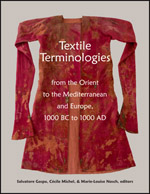Center, Textile Research

Textile Terminologies from the Orient to the Mediterranean and Europe, 1000 BC to 1000 AD
Date of this Version
2017
Document Type
Article
Citation
In Textile Terminologies from the Orient to the Mediterranean and Europe, 1000 BC to 1000 AD, ed. Salvatore Gaspa, Cécile Michel, & Marie-Louise Nosch (Lincoln, NE: Zea Books, 2017), pp. 19-23.
doi:10.13014/K2H993CD
Abstract
The first published volume dedicated to the diachronic study of ancient textile terminologies gathered contributions on Semitic and Indo- European studies based on texts dated mainly to the 3rd and 2nd millennium BC.1 It provided a rich body of data and the first steps in elaborating a methodology of how to analyse textile terminologies and technologies according to various categories. Yet, it also highlighted the problems that were encounter in such studies. For example, some areas such as Greece, Italy, Anatolia and Italy are rich in texts providing numerous textile terms but do not yield many ancient textiles, which can be compared to the textile terminology. Likewise, other areas, such as Northern Europe and the Alpine region yield archaeological textiles but very few texts to document how the textiles were called.
Several technical words refer to ancient technologies, which are lost today, and thus difficult to understand for the modern scholar. The ancient vocabulary of colours and dye products is also often unclear to the modern reader. Moreover, translations of ancient texts do not always convey correctly the techniques and tools described in the texts, but rather reflect the philologist’s poor understanding of textile techniques. Likewise, ancient (male) authors of high social and economic status did probably enjoy textile qualities but did not necessarily know the technicalities of manufacture, or chose deliberately to be vague about them for poetic purposes. It is therefore highly necessary to embark on more precise studies of textile terminologies, in order to be able to embed this body of knowledge into the understanding of the past.
This new volume includes 35 contributions by 41 experts, exploring a wide range of Indo-European languages, as well as Semitic, Sino-Tibetan, and Japonic languages, spoken and written down between the 1st millennium BC and the 1st millennium. They represent a unique and impressive amount of data; in addition, they offer many new approaches to textile terminologies and help to answer crucial questions concerning, among others, the nature of textile terminologies and their position and inclusion into languages, the characterisation of textile terminologies as specialised, technical language or fully integrated in the generalised language; the relationships between textile terms and technologies, geographical provenance, fashion, or social strata; the distribution and mobility of loanwords; the use of textile and garment terms in figurative language and metaphors.
The fields of textile terminology include terms for garments, fabric types, weaves, textile tools, textile craft professions, dyes and dye plants. Several authors draw inspiration and comparative data from iconography, chemical analyses of dyes, and modern ethnographic surveys.
Included in
Ancient History, Greek and Roman through Late Antiquity Commons, Art and Materials Conservation Commons, Classical Archaeology and Art History Commons, Classical Literature and Philology Commons, Fiber, Textile, and Weaving Arts Commons, Indo-European Linguistics and Philology Commons, Jewish Studies Commons, Museum Studies Commons, Near Eastern Languages and Societies Commons, Other History of Art, Architecture, and Archaeology Commons


Comments
Copyright © 2017 Salvatore Gaspa, Cécile Michel, & Marie-Louise Nosch. Photographs copyright as noted.